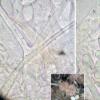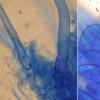
09-05-2013 18:41
 Nicolas VAN VOOREN
Nicolas VAN VOOREN
Bonjour.Voici un petit disco récolté sur pelotte

23-06-2015 22:02
Quijada LuisHi All, I would like to know if someone has colle

24-06-2015 20:08
Carmel SammutFound under olive tree - on dead olive leaf (could

23-06-2015 21:32
 Zuzana Sochorová (Egertová)
Zuzana Sochorová (Egertová)
Hello,this fungus was found in a tropical lowland

23-06-2015 13:52
Hi to everybody On last spring my friend Mikel T

23-06-2015 13:04
 Yatsiuk Iryna
Yatsiuk Iryna
Hello! I collected this Trichopeziza(?) on dead s

23-06-2015 17:02
Found in Abies cephalonica, 23-06-15. With Melzer,

23-06-2015 09:04
Marja PennanenHi,here's another mystery. These are about 0,2 mm
 Bonjour.
Bonjour.Voici un petit disco récolté sur pelotte de réjection (probablement d'un rapace), en compagnie d'Ascobolus brassicae. L'allure générale fait penser à un Lasiobolus pâle, de couleur blanchâtre à rosé, de 0.1-0.2 mm Ø.
Micro : excipulum de textura angularis, tendant vers prismatica, à cellules de 10-21 x 7.5-10 µm. Poils hyalins, 65-320 x 6-16 µm, cloisonnés (1-4), à paroi très épaisse, x 1.8-3 µm, réfringente, à base à plusieurs racines, et parfois bifides. Asques claviformes, 80-120 x 17-23 µm, sans crochet. Paraphyses non élargies au sommet, x 2.5-4 µm. Spores ellipsoïdales, 18-21.5 x (9) 10-11 (12) µm, hyalines, non guttulées, paraissant lisses dans l'eau mais à surface rugueuse dans le BC.
Je joins une photo et un PDF présentant les caractères micros (barres d'échelle = 10µm).
J'ai éliminé les genres Lasiobolus et Trichobolus, de même que Luciotrichus lasioboloides qui a des spores verruqueuses. Reste, d'après moi, deux options :
- genre Cheilymenia : à chercher du côté des formes albiniques, mais ça me paraît excessivement petit pour le genre...
- genre Trichophaeopsis : pas connaissance d'un "coprophile" à asque octosporé.
Si quelqu'un a une idée !

Effectivement plutôt déroutant, mais pourquoi pas un Cheilymenia malgré la petitesse. L'implantation des poils est elle uniquement marginale ? On voit sur la photo qu'un poil est bifide; cela peut il être une indication ?
Désolé de ne pouvoir t'aider davantage.
Michel.

Chers collègues,
Pour s’assurer, ou non, de la présence d’une espèce du genre Cheilymenia, il suffit de chauffer la préparation dans le bleu coton lactique (important) jusqu’à ébullition. Si la paroi externe des ascospores se décollent, il s’agit d’une espèce du genre Cheilymenia, devraient aussi apparaître l'ornementation sporale (se produit également chez quelques espèces du genre Scutellinia (non coprophiles) dont les ascosporpes sont, elles, guttulées). Bien sûr, tout ceci à maturité !
Cordialement
René


Michel.

I agree with you and Michel, this should be Trichobolus dextrinoideosetosus.
In 2013 I did a portrait of this species at Pilzforum.eu.
You can find it here:
http://www.pilzforum.eu/board/thema-trichobolus-dextrinoideosetosus-pilzraetsel-nach-12-jahren-geloest
There you can see also some further and very nice pics made by Björn Wergen.
I know this 8-spored Trichobolus from 11 gatherings in Germany (9 rabbit, 2 hare; first find in 2001).
Sorry, the posting is in german, but you can compare with the pictures.
Norbert


 Caractères microscopiques
Caractères microscopiques